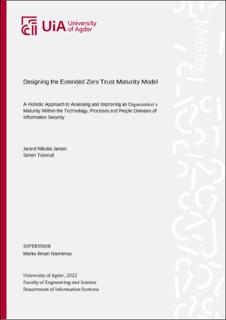| dc.description.abstract | Zero Trust is an approach to security where implicit trust is removed, forcing applications, workloads, servers and users to verify themselves every time a request is made. Furthermore, Zero Trust means assuming anything can be compromised, and designing networks, identities and systems with this in mind and following the principle of least privilege. This approach to information security has been coined as the solution to the weaknesses of traditional perimeter-based information security models, and adoption is starting to increase. However, the principles of Zero Trust are only applied within the technical domain to aspects such as networks, data and identities in past research. This indicates a knowledge gap, as the principles of Zero Trust could be applied to organizational domains such as people and processes to further strengthen information security, resulting in a holistic approach. To fill this gap, we employed design science research to develop a holistic maturity model for Zero Trust maturity based on these principles: The EZTMM. We performed two systematic literature reviews on Zero Trust and Maturity Model theory respectively and collaborated closely with experts and practitioners on the operational, tactical and strategic levels of six different organizations. The resulting maturity model was anchored in prior Zero Trust and maturity model literature, as well as practitioner and expert experiences and knowledge. The EZTMM was evaluated by our respondent organizations through two rounds of interviews before being used by one respondent organization to perform a maturity assessment of their own organization as a part of our case study evaluation. Each interview round resulted in ample feedback and learning, while the case study allowed us to evaluate and improve on the model in a real-world setting. Our contribution is twofold: A fully functional, holistic Zero Trust maturity model with an accompanying maturity assessment spreadsheet (the artifact), and our reflections and suggestions regarding further development of the EZTMM and research on the holistic application of Zero Trust principles for improved information security. | |
